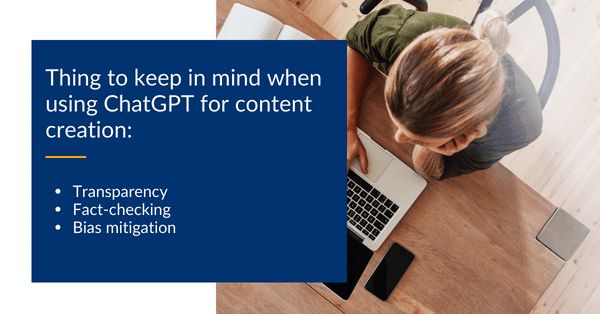Mastering the art of ChatGPT writing is a skill that can elevate your content to new heights. In this blog post, we will explore valuable tips and tricks for success in ChatGPT writing. Whether you’re a seasoned writer or just starting, these insights will help you harness the power of ChatGPT to create engaging and compelling content. From understanding the nuances of language to leveraging the capabilities of ChatGPT, this guide will equip you with the tools you need to excel in this exciting field. Get ready to unlock your writing potential!
Understanding the basics of ChatGPT writing
ChatGPT is an incredible tool that allows you to generate text by interacting with an AI-powered language model. To make the most out of ChatGPT, it’s essential to understand the basics of how it works. Simplilearn has a great explanation about this:
- Be specific. The more specific you are in your prompt, the better ChatGPT will be able to understand what you want. For example, instead of asking ChatGPT to “write a story,” you could ask it to “write a story about a robot who falls in love with a human.”
- Use keywords. When you’re writing your prompt, try to use keywords that are related to the topic you want ChatGPT to write about. For example, if you want ChatGPT to write a poem about love, you could use keywords like “love,” “romance,” and “heartbreak.”
- Use examples. If you can, provide ChatGPT with examples of the kind of content you want it to generate. For example, if you want ChatGPT to write a song, you could provide it with examples of songs that you like.
- Set a length limit. ChatGPT can generate text of any length, but it’s often helpful to set a length limit. This will help ChatGPT to focus on generating high-quality content that is the right length for your needs.
- Be patient. ChatGPT can take a few seconds to generate content, so be patient and let it do its work.
Crafting engaging and natural-sounding conversations:
One of the advantages of ChatGPT is its ability to generate natural-sounding conversations. To make your content engaging and conversational, follow these tips:
- Use conversational language: Write prompts and responses as if you’re having a conversation with ChatGPT. This makes the content more relatable and engaging for readers.
- Maintain a conversational flow: Keep the conversation flowing naturally by asking follow-up questions and providing appropriate responses. This creates a sense of interaction and keeps readers engaged.
- Inject personality and emotions: Add personality and emotions to your prompts and responses. This helps create a connection with the reader and makes the conversation more appealing.
Remember that balance is key. Balancing between making the content conversational and ensuring it remains coherent and informative is important. Avoid excessive slang or informal language that may undermine the credibility of the content.
Leveraging ChatGPT for content creation:

According to this article on LinkedIn, maximizing the potential of ChatGPT for content creation involves knowing how to ask. Here are some practical tips:
1. Brainstorming Content Ideas
Use a simple prompt like, “Generate 10 blog post ideas for a digital marketing agency specializing in small businesses.”
2. Drafting Content
For example, “Write an introductory paragraph for a blog post on ‘Leveraging Social Media for Small Business Growth’.”
3. Creating Social Media Captions
You could say, “Craft a compelling Instagram caption for a post promoting a new marketing masterclass.”
4. Generating SEO-Friendly Content
Make sure to incorporate SEO keywords into your prompts, like, “Write a blog post about ‘Improving SEO for Small Businesses’ incorporating the keywords ‘SEO’, ‘small business’, and ‘digital marketing’.”
Avoiding common pitfalls in ChatGPT writing

While ChatGPT is a powerful tool, there are certain pitfalls to be aware of. Here are some common challenges and how to overcome them:
1. Lack of context
ChatGPT may generate responses that lack context or fail to understand specific nuances. Providing clear and detailed prompts can help mitigate this issue.
2. Bias and misinformation
ChatGPT may inadvertently generate biased or inaccurate information. Fact-check the generated content and be cautious when using ChatGPT for sensitive or controversial topics.
3. Over Reliance on ChatGPT
ChatGPT should be treated as a tool to assist in content creation, not a replacement for human creativity and expertise. Use ChatGPT as a starting point and always review and edit the generated content.
Being aware of these pitfalls can help you navigate the world of ChatGPT writing more effectively and produce high-quality content.
Best practices for training and fine-tuning ChatGPT models:

Fine-tuning a ChatGPT model involves retraining it on a smaller dataset that’s specific to your use case. According to Cloudbooklet, here are the steps you need to follow:
1. Choose the Right Pre-Trained Model:
There are several pre-trained ChatGPT models available, such as GPT-3.5 and GPT-4. Choose the one that’s most appropriate for your use case based on the size of your dataset and the complexity of your task.
2. Collect and Clean Your Dataset:
To fine-tune your ChatGPT model, you’ll need to collect a smaller dataset that’s specific to your use case. This dataset should be clean and well-structured, with a clear and consistent format.
3. Train Your Model:
Once you have your dataset, you can start training your ChatGPT model using transfer learning. Transfer learning is a technique that involves reusing pre-trained models and modifying them to perform new tasks.
4. Test and Evaluate Your Model:
After training your model, you need to test it and evaluate its performance. Use a validation set to measure the accuracy and relevance of your model’s responses.
5. Fine-Tune Your Model:
Based on the results of your evaluation, you can fine-tune your model by adjusting its hyperparameters, such as the learning rate and the number of epochs. You can also add more data to your training set or change the architecture of your model to improve its performance
Ethical considerations in ChatGPT writing:

As with any AI-powered tool, there are ethical considerations to keep in mind when using ChatGPT for content creation. Here are some important points to consider:
- Transparency: Clearly indicate when content is generated by ChatGPT to avoid misleading readers. Transparency builds trust and helps readers understand the limitations of AI-generated content.
- Fact-checking: Verify the accuracy of the generated content before publishing or sharing it. You should also take responsibility for ensuring the information is reliable and unbiased.
- Bias mitigation: Be cautious of potential biases in the generated content and take steps to mitigate them. Consider different perspectives and aim for fairness and inclusivity.
By considering ethical standards in ChatGPT writing, you can maintain credibility, build trust with your audience, and contribute to a responsible and informed content ecosystem.
Conclusion
We hope you enjoyed our latest blog post on ChatGPT writing! Please contact us if you have any questions about ChatGPT writing tips or if you’re interested in learning more.
Keep an eye on our blog for more of our upcoming articles and insights into the latest in conversational AI!
If you liked this article, please share it with your friends and family. If you have any questions, please contact us anytime by filling out this form here.
Thanks for reading!
Before you go, I want to offer you something. It is a done-for-you service where we help you maximize your marketing and sales effectiveness by streamlining manual, tedious, and time-consuming tasks in the sales process so you can focus less on the admin work and more on selling. It will save your business time and money and make your business more effective.
We guide you through the process and help you set up the right tools for your company and price point so you can stay focused on things that really matter – building your business and making huge sales.

SEO content writing not only helps you create high-quality, keyword-focused content that ranks well in search engines and generates organic traffic to your website, but it also helps you convert that traffic into leads and sales.
With Your Own SEO Content Machine Working For You 24/7, You Can Spend Less Time Marketing & Launching — And More Time Doing What You Love.
This Service is RIGHT for you if you are:
Someone who is just starting out with their business and wants to make their day-to-day activities by managing leads and sales – easy breezy
- Someone who already has a business but needs help converting their leads to paying customers.
- Someone who is having a lot of new business but is struggling to keep up with managing all the leads and tasks.
- Someone who has a lot of leads but doesn’t know how to keep up with the details of each customer.
- Someone who needs help managing your old and new leads and maintaining them as customers.
You can read more about it here.






0 Comments